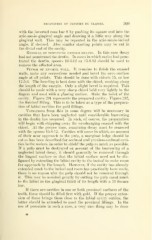Page 461 - My FlipBook
P. 461
EXCAVATION Or CAVITIES BY CLASSES. 209
with the inverted cone l)ur 8 l)y pushing its square end into tlio
axio-mesio-gingival angle and drawing it a little way along the
gingival wall. This may be repeated in the axio-mesio-incisal
angle, if desired. Also similar starting points may be cut in
the distal end of the cavity.
Removal of bemaining carious dentin. In this case decay
had not penetrated the dentin. In cases in which caries had pene-
trated the dentin, spoons 10-6-12 or 15-8-12 should be used to
remove the affected area.
Finish of enamel wall. It remains to finish the enamel
walls, make any corrections needed and bevel the cavo-surface
angle at all points. This should be done with chisels 15, or hoe
12-5-6. The beveling is best done with the chisel, working along
the length of the margin. Only a slight bevel is required. This
should be made with a very sharp chisel held very lightly in the
fingers and used with a planing motion. Make the toilet of the
cavity. Figure 291 represents the prepared cavity ; Figure 292,
the finished filling. This is to be taken as a type of the prepara-
tion of labial cavities for gold fillings.
Variations from this in some degree will be necessary in
cavities that have been neglected until considerable burrowing
in the dentin has occurred. In such, of course, the preparation
will begin with chipping away the overhanging enamel with the
chisel. At the proper time, remaining decay must be removed
with the sjioons 15-8-12. Cavities will occur in which, on account
of their near approach to the ]3ulp, a marginal ledge should be
cut as has been described for occlusal and proximo-occlusal cavi-
ties in the molars, in order to shield the pulp as much as possible.
If a pulp must be destroyed on account of the burrowing of a
neglected labial decay, it should generally be removed through
the lingual surface so that the labial surface need not be dis-
figured by extending the labial cavity to the incisal to make room
for approach by the broach. However, if the cavity has already
extended much to the incisal and room has practically been made,
there is no reason why the pulp should not be removed through
This may be assisted greatly by cutting the pulp canal much
it.
to the labial in the gingival third of its length with a 10 fissure
bur.
If there are cavities in one or both proximal surfaces of the
tooth, these should be filled first with gold. If the proper exten-
sion of these brings them close to the labial cavity outline, the
latter should be extended to meet the proximal fillings. In the
use of porcelain in such a case, a very nice thing may be done
so


